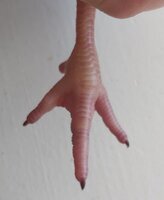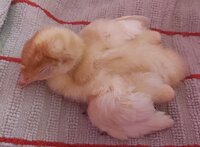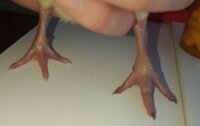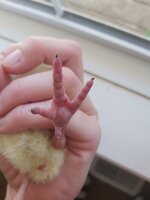shaneensmith
Songster
MY POULTS ARE GONIG LAME + SOME HAVE DIED (unsure if its connected)
New poults. Day Old's.
Coop Setup: 3 lamps in a neat row, disinfected coop, coop is ventilated, have not had birds for over 6 months (HAD a problem with infectious cryoza in laying hens - BUT haven't had birds for quite some time). My coop, completely bleached, disinfected with Simple Green Poultry House Cleaner, laid down wood pellets, then a 8 inch or more layer of pine shavings. Plus all new feeders and waterers (I was just told by @R2elk not to use shavings, but I was told by the hatchery to use shavings.

 Feed: 26% chick starter (new bag from Co-Op)
Feed: 26% chick starter (new bag from Co-Op)
 Fresh Water: with Pol-Vite
Fresh Water: with Pol-Vite
 I had them 1.5 days
I had them 1.5 days
>>> and 2 died.
 On the 2.5th Day
On the 2.5th Day
>>> 1 more died.
that night, noticed, lameness.
 On the 3rd day
On the 3rd day
>>> 2 went lame, 1died.
1 of the 2 was suffering badly, we euthanized it.
 They were ok for Saturday, and some of Sunday and now Monday . . .
They were ok for Saturday, and some of Sunday and now Monday . . .
>>> 3 more are lame.
1 of the 3 was very weak, I saw it poop SUPER DARK poop, then it pooped again, it cant move - we euthanized just now.
THIS ARTICLE STATES https://bit.ly/2xN3Wz5
https://bit.ly/2xN3Wz5
"Rule of thumb: In general, deaths in chicks in approximately the first 3-4 days post-hatch are closely linked to the quality of the day-old chicks from the hatchery."
"If you see lame chicks or huddled chicks below seven days of age, the cause is often related to a bacterial infection from bacteria such as E. coli, Salmonella, Streptococcus or Enterococcus."
New poults. Day Old's.
Coop Setup: 3 lamps in a neat row, disinfected coop, coop is ventilated, have not had birds for over 6 months (HAD a problem with infectious cryoza in laying hens - BUT haven't had birds for quite some time). My coop, completely bleached, disinfected with Simple Green Poultry House Cleaner, laid down wood pellets, then a 8 inch or more layer of pine shavings. Plus all new feeders and waterers (I was just told by @R2elk not to use shavings, but I was told by the hatchery to use shavings.
>>> and 2 died.
>>> 1 more died.
that night, noticed, lameness.
>>> 2 went lame, 1died.
1 of the 2 was suffering badly, we euthanized it.
>>> 3 more are lame.
1 of the 3 was very weak, I saw it poop SUPER DARK poop, then it pooped again, it cant move - we euthanized just now.
THIS ARTICLE STATES
"Rule of thumb: In general, deaths in chicks in approximately the first 3-4 days post-hatch are closely linked to the quality of the day-old chicks from the hatchery."
"If you see lame chicks or huddled chicks below seven days of age, the cause is often related to a bacterial infection from bacteria such as E. coli, Salmonella, Streptococcus or Enterococcus."
----------
My question is. Would they have gotten
E. coli, Salmonella, Streptococcus or Enterococcus FROM my disinfected coop? OR because they died so quickly within 1.5 days from the hatchery. Is it possible it has something to do with the hatchery and how they did it or their conditions?
Thanks everyone, I am at a loss and I have sent off 2 poults for necropsy.
My question is. Would they have gotten
E. coli, Salmonella, Streptococcus or Enterococcus FROM my disinfected coop? OR because they died so quickly within 1.5 days from the hatchery. Is it possible it has something to do with the hatchery and how they did it or their conditions?
Thanks everyone, I am at a loss and I have sent off 2 poults for necropsy.
Attachments
Last edited:








 Thanks for sharing your necropsy results.
Thanks for sharing your necropsy results.